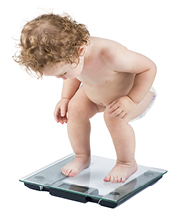Obese child, obese adult?
By Solveig A. Cunningham, Assistant Professor of Global Health

A parent who pushes a child to eat broccoli but drinks a “forbidden” soda sends clear and unintended messages about healthy eating, notes Solveig A. Cunningham. Photo by Kay Hinton
Four-year-old Johnny is heavy for his age. "Oh, he’s getting ready to shoot up," says his mother, who thinks he’s about to experience a growth spurt. Or is he?
Johnny may be among the 12% of American children who are obese by age 5. The prevalence of childhood obesity in the United States has almost tripled during the past three decades. According to the most recent national estimates, 32% of American children are overweight and another 17% are obese. Given the associations between obesity and diabetes, cardiovascular disease, and other major health problems, the implications for any obese child (or adult) are serious. But will an obese child grow up to be an obese adult?
|
|
Adults often find that excess pounds are hard to shed. Now we are learning that weight tends to accumulate rather than dissipate for young children. One in three overweight kindergartners will be obese in middle school—a fourfold greater risk of obesity than their normal-weight classmates. Among children who were obese during middle school, nearly half were overweight when they began kindergarten. And managing weight only gets harder with age: For teenagers who are obese in high school, only 2% are normal weight when they are in their 30s. Sadly, once a child becomes obese, he or she is at great risk of being obese for life.
Chubbiness in children is often dismissed as baby fat or as a phase of growth; indeed, having a child who is big for his or her age is often a point of pride for parents, who are eager to ensure that their babies are growing and eating sufficiently. Childhood is a time of major developmental changes, and some children grow faster and bigger than others. Still, there is mounting evidence from my research team at Rollins and other experts that if children are heavy for their height given their age and gender, they are at great risk of becoming obese. Only a minority of children who are obese at any point in childhood become normal weight later.
Weight trajectories seem to be set in place even earlier in life than most of us would expect. Obese parents tend to have obese children. A child’s body proportions are linked to those of his or her father and even more strongly with those of his or her mother. The mother’s own weight during pregnancy and whether she has diabetes are risk factors for obesity in the next generation. Babies born large—more than 8 pounds, 8 ounces—represent only 12% of babies in the United States yet make up 36% of obese middle-schoolers.
The extent to which family similarities result from shared behaviors between parents and children, biological predispositions, or a combination of the two, are yet to be better understood. However, identifying children who are at higher risk of obesity is an important step in understanding which families could benefit most from prevention efforts. Programs that have been most successful in treating childhood obesity engage the entire family and elicit behavioral change not just from the child but also from other family members.
Adults are models for children, including their habits and preferences about eating and physical activity. Children imitate what they see others doing and so can form healthy or unhealthy behaviors. Even as toddlers, children start taking cues from their surroundings and others around them as they decide what they like, what to eat, and how active to be. Children like to eat and do what their parents like, and a parent who pushes a child to eat broccoli but drinks a "forbidden" soda sends clear—and unintended—messages. Pressuring children to eat well can place value on unhealthy foods and devalue healthy foods, and pushing them to eat more or less can deregulate their eating by separating the act of eating from the feeling of hunger. While some health professionals think of healthy living as "common sense," it may not be as simple as it sounds—with an obesity epidemic as standing proof of that complexity. Now is the time, while Johnny is in preschool, to help him not top the growth chart and set his course to a healthy adulthood.
 |
||||

